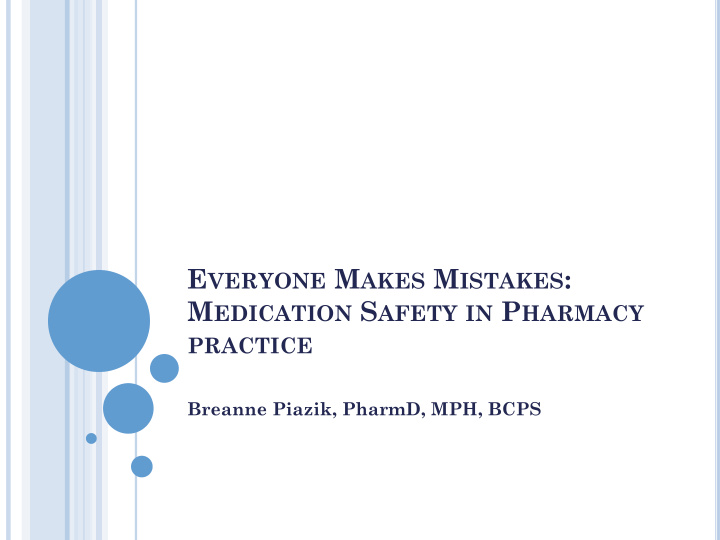



E VERYONE M AKES M ISTAKES : M EDICATION S AFETY IN P HARMACY PRACTICE Breanne Piazik, PharmD, MPH, BCPS
O BJECTIVES Identify medication errors Describe common factors that may contribute to medication errors Identify strategies for preventing errors Describe how to respond to a medication error
S TATEMENT OF D ISCLOSURE I have no conflicts of interest.
W HAT IS A M EDICATION E RROR ?
W HAT IS A MEDICATION ERROR ? Any preventable event that may cause or lead to inappropriate medication use or patient harm while the medication is in the control of the health care professional, patient, or consumer. About Medication Errors. (2015, January 30). Retrieved from https://www.nccmerp.org/about-medication-errors
I S THIS A MED ERROR ? Patient received ketamine drip that was 10 times the prescribed concentration Patient developed hives after amoxicillin administration Azithromycin was reconstituted incorrectly, but was caught before it was dispensed to the patient Patient received a dose of diltiazem IR 240 mg
C ATEGORIZING M EDICATION E RRORS Where it happens in the process Prescribing/monitoring Storing/dispensing/preparing Administering Outcome to the patient Was there harm? If there was harm, was it temporary? Did we need to intervene?
C ATEGORIZE THE E VENT Patient received ketamine drip that was 10 times the prescribed concentration Patient developed hives after amoxicillin administration Azithromycin was reconstituted incorrectly, but was caught before it was dispensed to the patient Patient received a dose of diltiazem IR 240 mg
H OW D O M EDICATION E RRORS H APPEN ?
H OW DO MEDICATION ERRORS HAPPEN ? Look Alike Sound Alike Medications
https://www.ismp.org/sites/default/files/attachments/2017-11/tallmanletters.pdf
H OW DO MEDICATION ERRORS HAPPEN ? Communication Abbreviations/slang tPA vs. TPN vs. TXA 1 levo … Accents 15 vs. 50 Handwriting 2 1. ISMP. (2015, Sep.) FDA Adviser-ERR: Avoide using the error-prone abbreviation, TPA. Retrieved from https://www.ismp.org/alerts/fda-advise- err-avoid-using-error-prone-abbreviation-tpa. 2. ISMP. (2015, Dec.) Health alert! Avandia, not Coumadin. Community/Ambulatory Care ISMP Medication Safety Alert! 14(12). Retrieved from https://www.ismp.org/communityambulatory/medication-safety-alert-december-2015.
H OW DO MEDICATION ERRORS HAPPEN ? Staffing Staffing patterns Are enough staff scheduled during the busiest times of the day? Call outs Are call outs covered? Can certain tasks be postponed/delayed? Training Are staff competent to perform the tasks that are asked of them?
H OW DO MEDICATION ERRORS HAPPEN ? Lack of knowledge Patient information Allergy information Medication list Pharmacies used Problem/condition list Lab values Medication information Dosing Administration Monitoring
H OW DO MEDICATION ERRORS HAPPEN ? Distractions Phone calls Interruptions Drive-thru System problems System defaults Shortcuts and hotkeys Dose warnings
H OW DO MEDICATION ERRORS HAPPEN ? Human error Confirmation Bias: search for and focus on information that supports what someone already believes, while ignoring facts that go against those beliefs 1 Psychology Today (2019). What is Bias? Retrieved from https://www.psychologytoday.com/us/basics/bias
H OW DO MEDICATION ERRORS HAPPEN ? S WISS C HEESE M ODEL Created by James Reason based on analysis of aviation errors Human error is inevitable Systems resemble stacked layers of Swiss cheese Active error: committed by individuals Latent error: flaws in system “Error waiting to happen” AHRQ. (2019, Jan.) Patient Safety Primer: Systems Approach. Retrieve from https://psnet.ahrq.gov/primers/primer/21.
The Swiss cheese model [online image]. (2019).Retrieved from https://www.cmpa- acpm.ca/serve/docs/ela/goodpracticesguide/pages/patient_safety/Systems/systems _thinking_2-e.html
S WISS C HEESE E XAMPLES ? Patient received ketamine drip that was 10 times the prescribed concentration Azithromycin was reconstituted incorrectly, but was caught before it was dispensed to the patient Patient received a dose of diltiazem IR 240 mg
W HAT C AN W E D O T O P REVENT E RRORS ?
R OOT C AUSE A NALYSIS Way to identify underlying causes of an event Usually involves a team Goal is to identify both active and latent errors What happened? Why did it happen? What can be done to prevent it from happening again? The cause mapping method of root cause analysis. (2019). Retrieved from https://www.thinkreliability.com/cause- American Society for Quality. (2019). What is root cause analysis (RCA)? mapping/what-is-root-cause-analysis/. Retrieved from https://asq.org/quality-resources/root-cause-analysis
R OOT C AUSES Error: Patient received ketamine drip that was 10 times the prescribed concentration Active errors: Incorrect product selection during dispensing Preparation with incorrect product Latent errors: Staffing Time pressure- nurse was waiting for medication Multiple ketamine concentrations available
R OOT C AUSES Error: Patient received a dose of diltiazem 240 mg IR Active errors: Incorrect product selection during prescribing Medication list was not updated Incorrect product verified for inpatient administration Latent errors: No dose warning fired Displayed in medical record as a prescription
W HAT CAN WE DO TO PREVENT ERRORS ? Open and honest reporting of errors Completely analyze errors to identify root causes Change processes to mitigate root causes Checklists Warnings Education Maximize visual differences Change storage locations Hard stops
W HAT CAN WE DO TO PREVENT ERRORS ? J UST C ULTURE Shift from punitive culture System of shared accountability Organizations are accountable for their systems Learning system constantly looking to improve Individuals are accountable for their behavior Human error At-risk behavior Reckless behavior Just Culture: Training for Managers. (2012). Plano, TX: Outcome Engenuity, LLC.
J UST C ULTURE I NVESTIGATION What happened? What normally happens? What is supposed to happen? Policy/procedure Why did it happen? What is the organization going to do to manage the risk?
W HAT D O W E D O W HEN W E D ISCOVER AN E RROR ?
W HAT DO WE DO WHEN WE DISCOVER AN ERROR ? Respond Ensure the patient is alright Intervene if necessary Notify the prescriber/patient Report CQI rules Prevent Change process as necessary as identified by error investigation
I N S UMMARY Be honest and open about errors Mistakes happen; everyone is human Report errors so others can learn Report errors so the system can improve Report errors for the patients’ sake Report errors because it is the right thing to do
Questions?
Recommend
More recommend